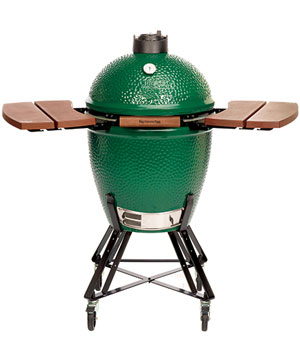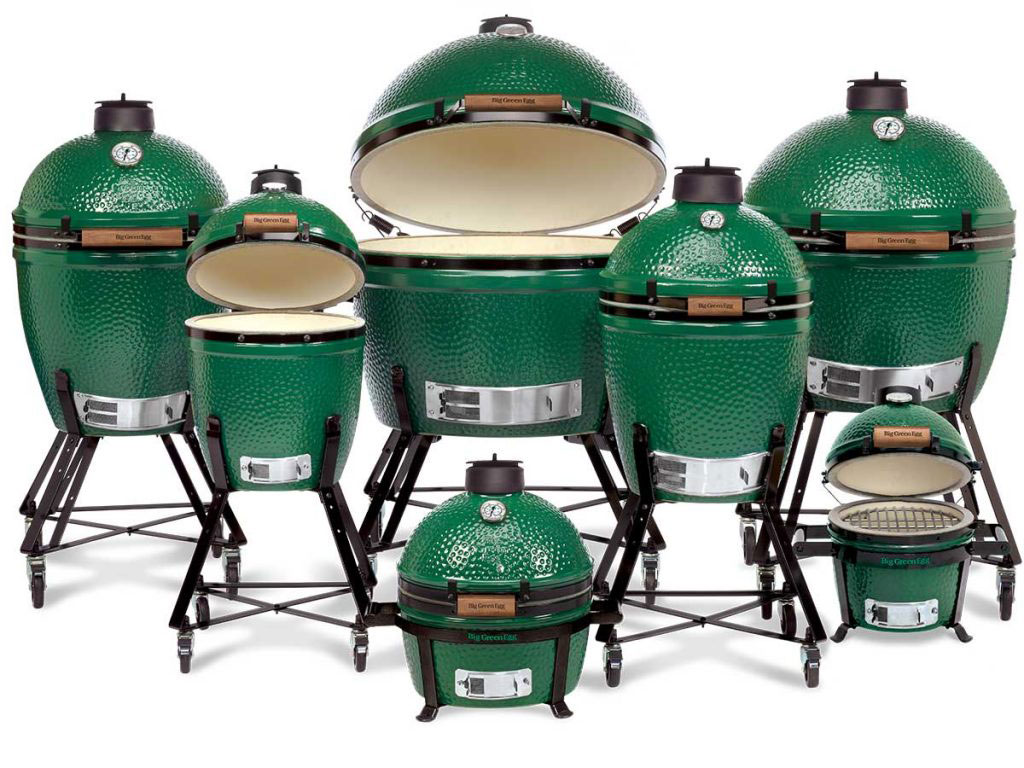
Kamado Grills – What’s all the fuss about?
Everyone seems to be talking about the Kamado grill and ceramic cookers these days, and there has been a rush of new companies entering the ceramic grill marketplace. You can even find a Kamado grill at your local Big Box retailer, so something must be going on. Right?
Right! Something definitely is going on. After decades of slow but consistent, below the radar screen growth, the Kamado grill is moving beyond its roots in the BBQ and smoking enthusiast communities and becoming a mainstream product. To borrow from language used by MBAs, or Silicon Valley marketing types, the Kamado grill has already moved from the “enthusiast” community to the “early adopter”, and it is showing signs of breaking through into the “early majority”, or mass market, which is really exciting.
But why is interest in the Kamado grill exploding? To a lot of people, the Kamado grill is both strangely shaped and very expensive — the Kamado grill will always be oddly shaped, though they are no longer too expensive. Still, we went shopping at Home Depot recently and talked with the manager of the BBQ and grill department about the new Kamado grill that was on display of the first time (the Big Box Kamado grill has been available through homedepot.com for a while, but having it in the stores is new), and he had no idea what it was, or why it was there.
In this case, the grill buyers at Home Depot know a lot more about the grill market than the guy on the showroom floor. The Kamado grill is the next Big Thing in grilling, and its time has arrived. And for some excellent reasons. The fundamental truth is that the Kamado grill is simply the best grill for outdoor cooking — regardless of price or fuel type. Period.
But we are getting ahead of ourselves. First, let’s cover a little background.
The History of the Kamado Grill
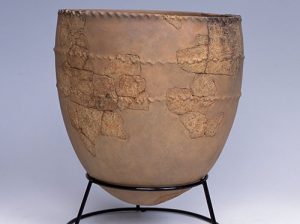
Ancient Japanese clay cooking vessel. From NPR.
From the good people at Wikipedia, you can see that the Kamado grill has been with us for a long time — virtually as long as man has been settled in villages and began farming and tending animals. Like other traditional cooking appliances, such as the brick bread oven and Tandoor, the Kamado grill is efficient with fuel, and it provides the cooking enthusiast with a more productive cooking environment that the modern steel oven or propane BBQ.
Clay vessels have been used by humans to cook food for many thousands of years. Clay cooking pots have been found in every part of the world, and some of the earliest dated by archaeologists to be over 3000 years old have been found in China and over 4000 years in Indus Valley Civilization, India. It is believed that in these circular clay cooking vessels are the origins of the modern Kamado, albeit the clay finally being superseded by ceramic materials.
All over the globe, this elementary cooking vessel has evolved in many different ways, the Tandoor, for example, in India and Japan, the mushikamado, a device designed to steam rice and used by Japanese families for ceremonial occasions. The mushikamado was a round clay pot with a removable domed clay lid and was typically found in Southern Japan. Innovations at this time included a damper and draft door for better heat control, and it was found to be fuelled by charcoal rather than wood.
The mushikamado first came to the attention of the Americans after the Second World War. The name kamado is, in fact, the Japanese word for “stove” or “cooking range”. Literally, it means “place for the cauldron”. The word has become a generic term for this style of ceramic cooker.
In case you were wondering, according to NRP, archeologists found that the first things we cooked in a clay pot was salmon soup, about 15,000 years ago. So we’ve had a long time to perfect this method of cooking.
While the Kamado grill found it’s way to the US in the aftermath of the Second World War — the brick oven and pizza were also discovered by Americans at the same time, it has taken decades for the Kamado to reach the mainstream. In the early days, GI’s brought Kamado grills back from Japan, and a few set up import companies. Everything was cheap and cheerful, and a lot of fun for the insiders. Of course, no one got too upset when their Kamado grill started falling apart because it was so cheap.
The rise of the serious Kamado grill began in the 1980s with the Big Green Egg, and although the Big Green Egg prices are high, the market has been growing in the low double digits ever since (check out our Big Green Egg Review). The cult of the Egg has been widely acknowledged, as it is beneficial for everyone — the manufacturer, the enthusiasts who have driven the market, and the marketplace itself. The development of durable, cost-effective Refractory Ceramics has enabled manufacturers to build Kamado grills that will last a lifetime and are still reasonably priced. In recent years Kamado Joe, Primo Grills, and Vision Grills have entered the Kamado grill market, along with several smaller companies, bringing selection and some competition to the market.
Today, most modern kamado grills are made from ceramics — though the quality and thickness of the ceramic materials vary widely. Still, the use of hig-quality ceramics has many advantages over other materials, such as steel, including the excellent heat retention properties of the ceramic material itself. Ceramic grills can retain heat for long periods of time, making them extremely versatile in the temperature ranges they can operate at, and in the variety of types of cooking they can do, including grilling, smoking, and baking. Kamados can consistently hold temperatures as low as 225° F, and reach and hold heat temperatures as high as 750°+ F. Using the vent system, precise control over airflow can be maintained, allowing kamados to deliver a moist baking and roasting environment, much like wood-fired ovens, so that they can be used to roast or bake anything.
Until now what has been missing from the Kamado grill market is an aggressive insurgent; the lean, focused, lowest-cost production company that is ready to move the market beyond just the enthusiasts and early adopters who historically have been willing to pay a much higher price to support their cooking hobby, into the mass market by establishing a new, and much higher, level of price/performance and value — and a new price point.
The Anatomy of the Kamado Grill
The Kamado grill, unlike a kettle or propane grill, is typically made from a refractory ceramic, and it uses charcoal — not propane as its fuel source. The Kamado grill is made up of several discrete ceramic parts that fit smoothly together without any screws, bolts, and glue, and without any tools, which makes servicing a Kamado grill something that you can easily do on your own.
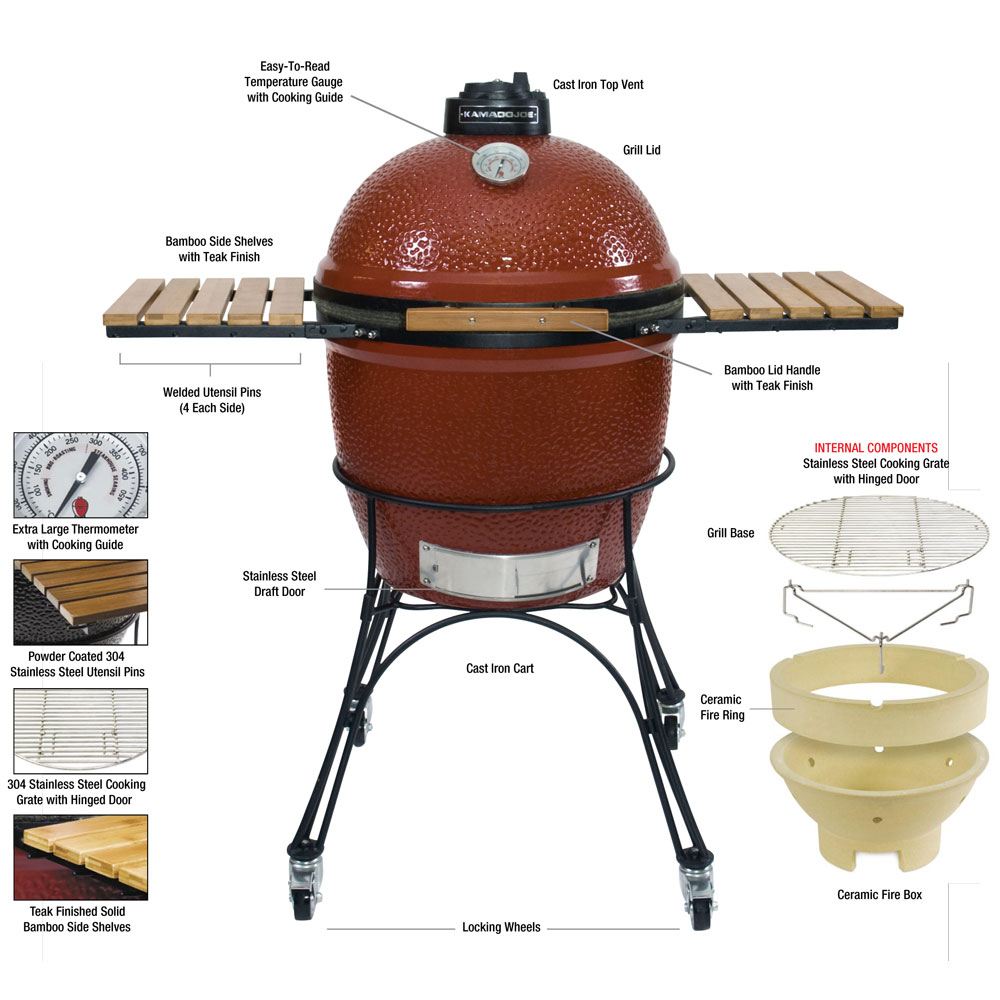
Going forward, we will be consistent with the words we use to describe the Kamado components. For example, we will use the term “grill” to describe the entire product — a Kamado grill, and we will use the term “grate” to describe the cast iron piece at the bottom of the firebox that actually holds the charcoal, as well as the metal cooking surface that gets hot to put sear marks on your meats and vegetables and holds various cooking accessories, such as pizza stones, grid doubles, heat deflectors, grid elevators and pans. We will call the top of the grill as the “lid”, as opposed to the dome, and the bottom will be called the “base”.
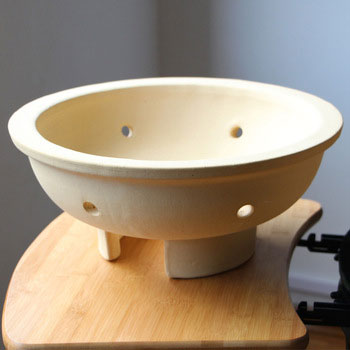
World-class refractory ceramics, a smooth firebox design, and industry-leading thickness deliver optimal airflow for a lifetime of great cooking.
The fire chamber is made up of the firebox, fire ring, and fire grate. These ceramic components should be about 1 1/4″ thick, and constructed using the highest grade refractory ceramics so that they retain heat, insulate the outer enclosure from the heat of the charcoal fire, and avoid cracking, chipping and spalling (a problem where the surface of the firebox and fire ring start to flake off with use). When designed and built correctly, a Kamado grill fire chamber should last a lifetime.
The Kamado grill’s airflow and temperature are controlled by a dual, top and bottom, ventilation control system, where cold air is drawn into the lower vent and exhausted through the top vent. By controlling the amount of air flowing through the grill, the chef is able to control the temperature of the grill very accurately. Cooking with the lid closed while you control the airflow, your Kamado grill is capable of maintaining both very slow and very high temperatures for long periods.
The heat “stored” in the refractory ceramic fire chamber is used for both low-temperature smoking and high-temperature searing, baking, and roasting. The natural flow of air through the grill creates natural convection — two of the key features that distinguish a ceramic grill from a metal kettle BBQ. The chef can also close both vents to cut off the air supply to the charcoal fire, putting it out and saving those coals to cook on another day.
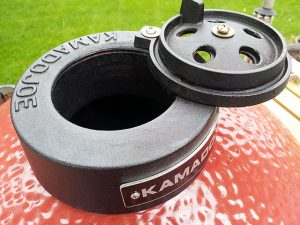
Hot air is exhausted through the adjustable top vent.
Because both the top and bottom vent become hot during the operation of the grill, they must be both constructed using the highest grade materials — typically cast iron for the top vent and stainless steel for the lower vent. You should avoid top or bottom vents made using cast aluminum, painted metal, or plastic, as they will corrode and break down.
The lower vent should slide easily, and the upper vent should take advantage of the dual-disk design, where the top vent can be opened entirely, using one hinge, and then more finely controlled using a radial hinge with smaller vent opening.
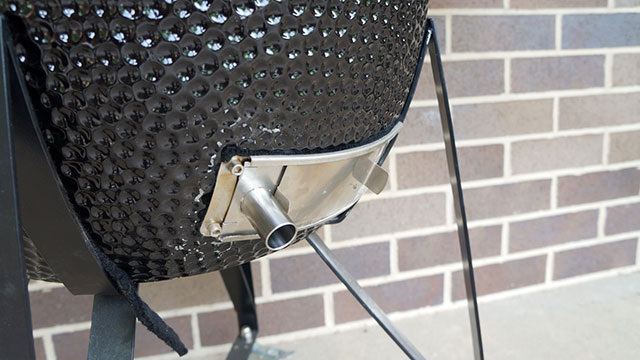
A stainless steel lower vent slides easily for accurate airflow control and is very durable.
The outer enclosure, made of up grill lid and base, should also be made using the highest grade of refractory ceramics (while it does not become as hot as the fire chamber, it does get hot), and it is finished with a colorful and durable ceramic glaze. When designed and built correctly, a Kamado grill should not only last a lifetime; it should look great for a lifetime.
Vibrant color and a brilliant glaze
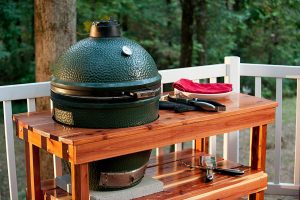
Kamado tables are custom designed to hold your grill. Pictured here a big green egg stand.
There are several different options for housing a Kamado grill, and we will use the terms “cart”, “table”, and “island” to describe them. A Kamado table has an opening for the Kamado grill and larger work surfaces on all sides of the grill, and it can be made with either wood, steel, or modern composite material. Outdoor kitchen islands are more substantial, with built-in outdoor cabinetry modeled after a regular indoor kitchen island, and they can be made from a wide range of materials, including metal studs or a welded aluminum frame covered with waterproof backer board and then finished with stucco, brick or stone, or they can be fabricated using stainless steel.
Kamado Grill Design
The ceramic Kamado grill design is entirely different from any other grill on the market. The primary design characteristic of the Kamado grill is the principal components are made from cast refractory ceramics, rather than metal. As you are learning, this design provide the backyard chef with a number of significant advantages over a metal grill, including sustained very low temperature cooking, sustained very high temperature cooking, a moist cooking environment that prepares better food, faster start times, more accurate temperature control, more efficient use of charcoal and easier clean up.
Refractory Ceramic Fire Box
The Kamado grill fire chamber is made up of three components: the firebox, the fire ring, and a grate. The firebox is a cast refractory ceramic component that holds the charcoal and provides airflow. The shape of the firebox should be optimized for efficient airflow without any linear angles, to enable optimal charcoal combustion and control over cooking temperature. Because the firebox is in physical contact with the charcoal that fires the grill, it must be thick (1 1/4″) and constructed using the highest grade refractory ceramic materials — a lower quality firebox will break down with the continual thermal expansion and contraction of starting the charcoal fire from a cold state, and from the thermal shock of cold liquids, such as drippings and marinades, hitting the hot firebox.
Refractory Ceramic Fire Ring
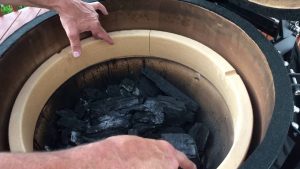
The fire ring provides the platform for the cooking grates.
The fire ring is also a cast refractory ceramic component that rests on top of the firebox and forms the sidewalls for the fire chamber and provides the platform for the cooking grates and other accessories you will use with your grill. Although the fire ring does not come in physical contact with your charcoal, it is still subject to the thermal expansion and contract cycle, and it is especially subject to thermal shock. The thickness of the fire ring casting is particularly important because it is a simple cast ring, a shape which is prone to cracking. In fact, the low-quality Big Box Kamado grill comes with a fire ring that has an “expansion gap” cut into the component — in other words that grill comes with the fire ring “pre-cracked” so that the customer won’t become upset or worried when that piece cracks under normal usage because the casting is too thin and uses a low-quality ceramic material.
Cast Iron Fire Grate
The bottom of the fire chamber features a cast iron fire grate, which rests on top of the firebox, holds the charcoal, and allows free airflow. Because the fire grate comes in physical contact with the charcoal and is exposed to high temperature and rapid cycling of temperatures from zero to 750ºF+, the fire grate must be constructed using thick cast iron.
Refractory Ceramic Grill Enclosure
While the lid and base of a Kamado grill are not exposed to the same high temperatures and temperature variation as the firebox and fire ring, they do none the less still get hot. When you are doing high-temperature baking for long periods, such as baking lots of pizza, the fire chamber components become increasingly hot, where their refractory ceramic material is effectively “filled up” with heat, that heat starts to migrate into the enclosure’s ceramic material. At some point, the outer edges of the enclosure base will become hot to the touch.
With this in mind, you can see that it is vital that the Kamado grill enclosure is cast using the same high-quality refractory ceramic as the fire chamber itself, and that the enclosure is thick enough to handle the heat and to stop the outer edge of the base to ever becoming too hot to the touch.
Kamado Grill Operation
While the Kamado grill and kettle grill both use charcoal fuel, the similarities pretty much stop there. Kamado grill operation is based on three design aspects, which are fundamentally different from either a gas or kettle grill:
- A refractory ceramic fire chamber that absorbs and reflects the heat of the charcoal fire, and insulates the exterior ceramic enclosure from the heat of the fire
- An airtight seal between the thick ceramic grill base and lid that holds the heat of the charcoal fire inside the cooking area and creates a natural convection oven effect, rather than merely releasing it through thin metal grill walls
- Refined control over the grill’s airflow and cooking temperature
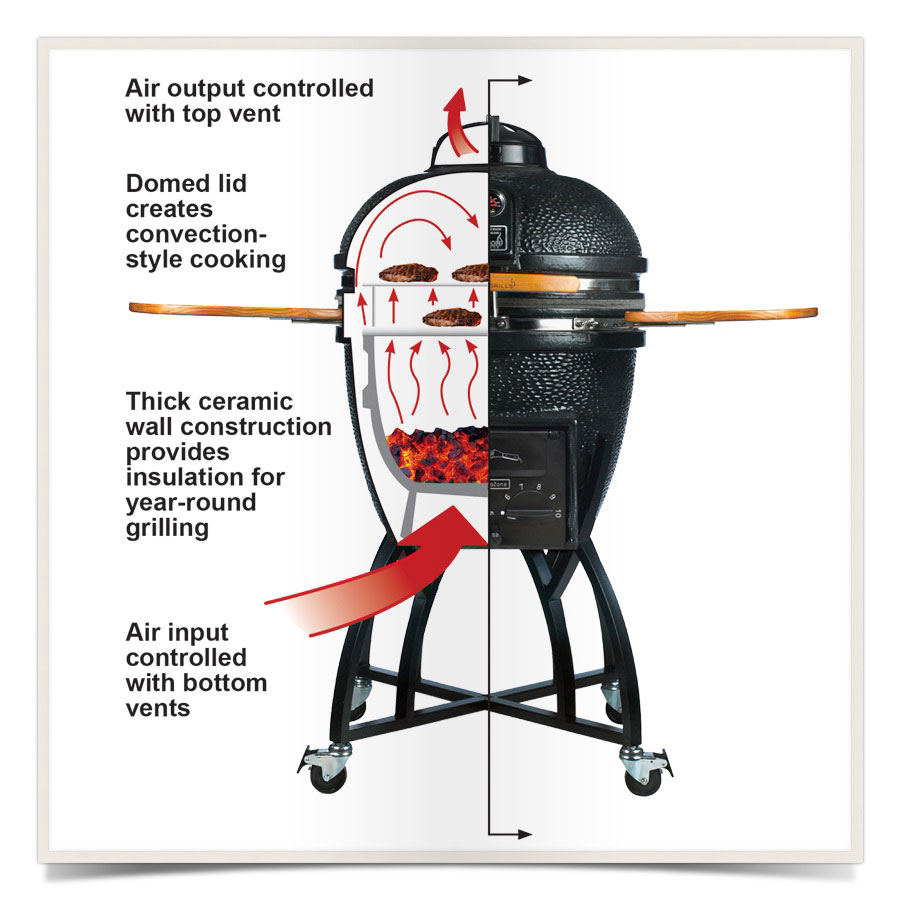
Air is drawn into the lower vent which feeds the fire and is exhausted through the top vent.
Air is drawn into the grill through the lower vent, where it feeds the charcoal fire and circulates inside the grill cooking chamber where it creates natural convection before it is finally exhausted through the top vent. There are a couple of aspects to this process that are noteworthy.
Natural Convection for Better Food
The airflow through a Kamado grill, combined with the grill’s domed shape and airtight seal, creates natural convection, where the cooking chamber is filled with moist, moving air on all sides of your food— providing the perfect cooking environment. All of your roast meats are cooked evenly, and they are moister and juicier. Further, the moist air in the cooking chamber allows you to cook at higher temperatures without burning your food, so that your food cooks faster, without drying out. Compare that with a gas grill, that lets heat escape from the top and sides, and cook primarily from below. Further, because they only cook from below, gas grills require more bottom heat and fuel to achieve the same overall temperature of a Kamado grill, robbing moisture from your meat, bread, and pizza. A Kamado grill keeps the heat in the cooking chamber and the moisture in the meat.
Naturally Fuel Efficient
One key advantage of a Kamado grill is the natural insulating properties of refractory ceramics, which means that less total heat and fuel are required to cook your food. Not only does this result in shorter cooking times and better-tasting food, but it also saves you money. A smaller charcoal fire is needed compared with a kettle grill, and when you are finished cooking, it is easy to close off the fire’s air supply, saving your charcoal to cook again — charcoal can last for 2-3 or more cooking sessions! A Kamado grill uses about half, or less, charcoal than a kettle grill, and it is capable of providing up to 18 hours of low-temperature smoking/grilling from a single load of charcoal.
Faster Start-Up
A Kamado grill can be ready to start cooking in about 17 minutes — faster than a kettle grill. The optimal airflow through the charcoal in the fire chamber provides the perfect environment for rapid combustion, and the grill’s refractory ceramics are natural insulators, efficiently reflecting the heat of the charcoal fire into the cooking area.
Accurate Temperature Control
If you are like us, you have many unhappy memories of burning food in your gas grill. Between flare-ups, and the fact that there is no easy way of controlling the surface temperature of the cooking grate, it is far too easy to ruin a beautiful cut of meat — and you feel awful when you do it. But temperature control is not a problem with a Kamado grill. With just a little bit of trial and error, you can quickly learn the settings and charcoal load that deliver the consistent temperatures you are looking for. Because the grill’s dome and base form an airtight seal and you always cook with the grill dome closed, flare-ups are much less of a problem. And unlike a typical gas grill, the temperature gauge on a Kamado grill is accurate, and you can trust it. Set it, and forget it.
Sustained Temperature Control for Smoking and Roasting
One of the most significant advantages of a Kamado grill is its ability to provide consistent temperature cooking at either very low or very high temperatures for long periods. As the ceramic material that makes up the Kamado grill absorbs the heat of the charcoal fire, it is effectively storing that heat and releasing it back into the grill’s cooking chamber as you cook. You can think of it as a back-up reserve of cooking heat. For low-temperature smoking, that heat reservoir helps the grill maintain an even temperature for hours. For high-temperature baking and roast — pizza, for example, a well-fired Kamado grill allows your grill to make the 750ºF+ temperatures you need to make great pizza, even as you are new pizzas, with cold, wet dough to your grill, and as you open the grill to add and remove pizza.
Easy Clean Up
Maintaining a Kamado grill and keeping it clean and looking great does not take a lot of effort. Because a Kamado grill can operate at higher temperatures, the walls of your grill will naturally stay clean with food and fat dropping burned off to become fine ash — think of the self-cleaning cycle on your indoor electric oven. Similarly, a hot, closed Kamado grill will burn most food stuck on the stainless steel cooking grate, making clean as simple as brushing off the grate. And finally, because a Kamado grill is so efficient with charcoal, there is very little ask to clean out of the grill, even with regular use.
Selecting the Right Kamado Grill
Kamado grills can be a huge investment so you want to be sure to do thorough research before making a purchase. Check out our Kamado grill reviews before you make the plunge!

